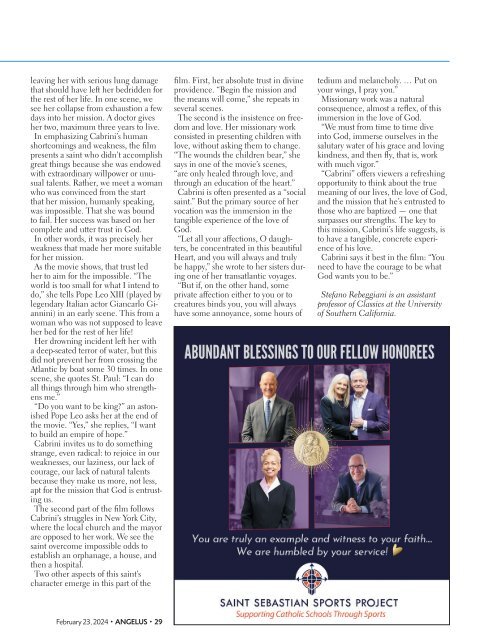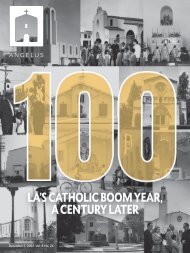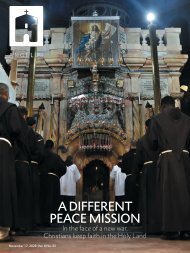Angelus News | February 23, 2024 | Vol. 9 No. 4
On the cover: A painting depicting Jesus in the Garden of Gethsemane by 19th-century artist Carl Heinrich Bloch. For Christians, Lent can be compared to the time Jesus spent praying in the desert. But we may also find ourselves this time of year in the agony of the garden, going through our own Gethsemane of personal suffering. On Page 10, Msgr. Richard Antall reflects on two traditional prayers to the same angel that comforted Christ on the Mount of Olives.
On the cover: A painting depicting Jesus in the Garden of Gethsemane by 19th-century artist Carl Heinrich Bloch. For Christians, Lent can be compared to the time Jesus spent praying in the desert. But we may also find ourselves this time of year in the agony of the garden, going through our own Gethsemane of personal suffering. On Page 10, Msgr. Richard Antall reflects on two traditional prayers to the same angel that comforted Christ on the Mount of Olives.
You also want an ePaper? Increase the reach of your titles
YUMPU automatically turns print PDFs into web optimized ePapers that Google loves.
leaving her with serious lung damage<br />
that should have left her bedridden for<br />
the rest of her life. In one scene, we<br />
see her collapse from exhaustion a few<br />
days into her mission. A doctor gives<br />
her two, maximum three years to live.<br />
In emphasizing Cabrini’s human<br />
shortcomings and weakness, the film<br />
presents a saint who didn’t accomplish<br />
great things because she was endowed<br />
with extraordinary willpower or unusual<br />
talents. Rather, we meet a woman<br />
who was convinced from the start<br />
that her mission, humanly speaking,<br />
was impossible. That she was bound<br />
to fail. Her success was based on her<br />
complete and utter trust in God.<br />
In other words, it was precisely her<br />
weakness that made her more suitable<br />
for her mission.<br />
As the movie shows, that trust led<br />
her to aim for the impossible. “The<br />
world is too small for what I intend to<br />
do,” she tells Pope Leo XIII (played by<br />
legendary Italian actor Giancarlo Giannini)<br />
in an early scene. This from a<br />
woman who was not supposed to leave<br />
her bed for the rest of her life!<br />
Her drowning incident left her with<br />
a deep-seated terror of water, but this<br />
did not prevent her from crossing the<br />
Atlantic by boat some 30 times. In one<br />
scene, she quotes St. Paul: “I can do<br />
all things through him who strengthens<br />
me.”<br />
“Do you want to be king?” an astonished<br />
Pope Leo asks her at the end of<br />
the movie. “Yes,” she replies, “I want<br />
to build an empire of hope.”<br />
Cabrini invites us to do something<br />
strange, even radical: to rejoice in our<br />
weaknesses, our laziness, our lack of<br />
courage, our lack of natural talents<br />
because they make us more, not less,<br />
apt for the mission that God is entrusting<br />
us.<br />
The second part of the film follows<br />
Cabrini’s struggles in New York City,<br />
where the local church and the mayor<br />
are opposed to her work. We see the<br />
saint overcome impossible odds to<br />
establish an orphanage, a house, and<br />
then a hospital.<br />
Two other aspects of this saint’s<br />
character emerge in this part of the<br />
film. First, her absolute trust in divine<br />
providence. “Begin the mission and<br />
the means will come,” she repeats in<br />
several scenes.<br />
The second is the insistence on freedom<br />
and love. Her missionary work<br />
consisted in presenting children with<br />
love, without asking them to change.<br />
“The wounds the children bear,” she<br />
says in one of the movie’s scenes,<br />
“are only healed through love, and<br />
through an education of the heart.”<br />
Cabrini is often presented as a “social<br />
saint.” But the primary source of her<br />
vocation was the immersion in the<br />
tangible experience of the love of<br />
God.<br />
“Let all your affections, O daughters,<br />
be concentrated in this beautiful<br />
Heart, and you will always and truly<br />
be happy,” she wrote to her sisters during<br />
one of her transatlantic voyages.<br />
“But if, on the other hand, some<br />
private affection either to you or to<br />
creatures binds you, you will always<br />
have some annoyance, some hours of<br />
tedium and melancholy. … Put on<br />
your wings, I pray you.”<br />
Missionary work was a natural<br />
consequence, almost a reflex, of this<br />
immersion in the love of God.<br />
“We must from time to time dive<br />
into God, immerse ourselves in the<br />
salutary water of his grace and loving<br />
kindness, and then fly, that is, work<br />
with much vigor.”<br />
“Cabrini” offers viewers a refreshing<br />
opportunity to think about the true<br />
meaning of our lives, the love of God,<br />
and the mission that he’s entrusted to<br />
those who are baptized — one that<br />
surpasses our strengths. The key to<br />
this mission, Cabrini’s life suggests, is<br />
to have a tangible, concrete experience<br />
of his love.<br />
Cabrini says it best in the film: “You<br />
need to have the courage to be what<br />
God wants you to be.”<br />
Stefano Rebeggiani is an assistant<br />
professor of Classics at the University<br />
of Southern California.<br />
<strong>February</strong> <strong>23</strong>, <strong>2024</strong> • ANGELUS • 29

















